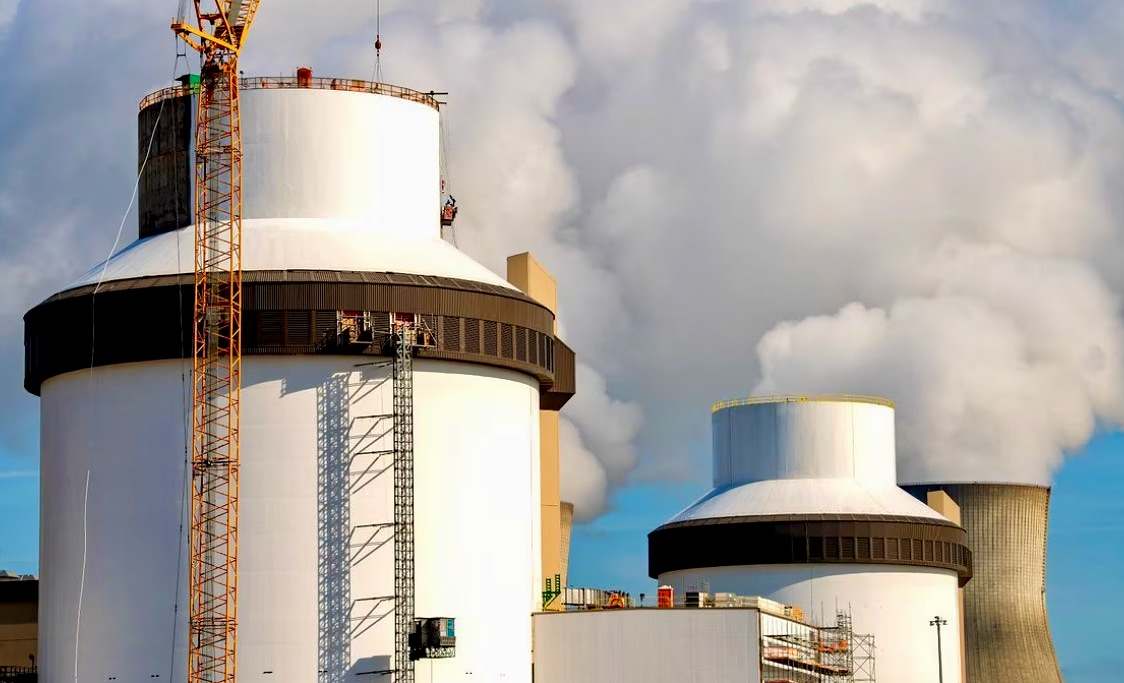|
Getting your Trinity Audio player ready...
|
Years behind schedule and billions of dollars over budget, reactor number three at the Alvin W. Vogtle electric generating plant (a.k.a. Plant Vogtle) in Burke County, Georgia is at long last splitting atoms.
The reactor reached “initial criticality” last Monday, meaning a fission chain reaction inside the unit has been sustained.
“Atoms are being split and nuclear heat is being made, which will be used to produce steam,” a statement from Atlanta-based Georgia Power noted.
Georgia Power is a subsidiary of Southern Company – a 45.7 percent stakeholder in Vogtle. Oglethorpe Power owns 30 percent of the project, while subsidiaries of the Municipal Electric Authority of Georgia own 22.7 percent. The remaining 1.6 percent is owned by Dalton Utilities.
Power inside the reactor will be brought to 100 percent over the coming weeks, at which point it will be linked to Georgia’s grid (likely in May or June of this year).

***
When that happens, Vogtle No. 3 will be the first nuclear reactor to enter commercial service in the United States in nearly seven years – and only the second reactor to come online in the 21st century (following Unit 2 at Tennessee’s Watts Barr nuclear plant). Its twin – Vogtle No. 4 – is scheduled to come online in the first quarter of 2024.
Combined, the two reactors will produce an estimated 2,234 megawatts of power each year.
All told, there are more than ninety active nuclear reactors at fifty-five different facilities in the United States generating approximately 20 percent of the nation’s electricity. Most of them came online in the 1970s and 1980s. America’s nuclear output peaked in 2012 at approximately 102,000 megawatts, according to data from the U.S. Energy Information Administration (EIA).
“We remain focused on safely bringing this unit online, fully addressing any issues and getting it right at every level,” Georgia Power’s leader Chris Womack said in a statement. “When you consider the history of safe and reliable operations at Vogtle Units 1 and 2 for decades now, it puts today’s milestone in perspective that Plant Vogtle will be a four-unit site making it the largest of its kind in the U.S. This is a truly exciting time as we prepare to bring online a new nuclear unit that will serve our state with clean and emission-free energy for the next 60 to 80 years.”
Vogtle No. 3 is a Westinghouse AP1000 pressurized water reactor – similar to the two abandoned units at the V.C. Summer nuclear generating station in Jenkinsville, S.C.
Remember that debacle?
Government-run utility Santee Cooper and its private sector partner, SCANA, were tasked with building two AP1000s in Jenkinsville at a cost of $9.8 billion. The money was spent, but the reactors weren’t completed – and the utilities couldn’t afford the $10-16 billion price tag necessary to finish them. Even worse, executives at both utilities knew the reactors were doomed for years and didn’t warn the public. Instead, they concealed this critical information from regulators while they continued to raise rates and rack up additional debt.
Santee Cooper, for example, flat out lied on bond documents … and attempted to raise rates on its customers just a week before pulling the plug on the project.
No Santee Cooper leaders were ever held accountable for their actions related to this scandal – which I christened #NukeGate. In fact, they were rewarded. Meanwhile, the state lawmakers who plunged the state into this debacle – most notably S.C. Senate judiciary committee chairman Luke Rankin – have continued to allow Santee Cooper to amass billions of dollars in new red ink.
Speaking of red ink, Vogtle is expected to wind up costing more than $35 billion – more than twice its initial estimate of $14 billion. That will make the power it produces over the coming decades far more expensive than originally projected. Georgia utility customers are already paying an estimated $900 on average this year in costs related to this oft-delayed project, according to recent testimony presented to the Georgia Public Service Commission (GPSC) – and additional rate hikes are expected once Vogtle No. 3 comes online.
While Vogtle’s delays have been costly, the carbon-free power generated by these two new reactors is absolutely critical to the nation’s energy future. Unfortunately, Vogtle is the only nuclear power project currently under construction in the United States – although earlier this year the Nuclear Regulatory Commission (NRC) approved a design concept for small, modular nuclear reactors that could enable utilities to avoid some of the headaches associated with the construction of traditional reactors.
“(Small modular reactors) are no longer an abstract concept,” assistant U.S. secretary for nuclear energy Kathryn Huff said in a statement. “They are real and they are ready for deployment thanks to the hard work of NuScale, the university community, our national labs, industry partners, and the NRC. This is innovation at its finest and we are just getting started here in the U.S.!”
***
ABOUT THE AUTHOR…

Will Folks is the founding editor of the news outlet you are currently reading. Prior to founding FITSNews, he served as press secretary to the governor of South Carolina. He lives in the Midlands region of the state with his wife and eight children.
***
WANNA SOUND OFF?
Got something you’d like to say in response to one of our articles? Or an issue you’d like to address proactively? We have an open microphone policy! Submit your letter to the editor (or guest column) via email HERE. Got a tip for a story? CLICK HERE. Got a technical question or a glitch to report? CLICK HERE.


3 comments
The SCANA Plant was the 4th and 5th nuke plants at Jenkinsville. VC Summer was one of 3 planed. Only 1 finished. The other 2: 1 had over $250 million in foundations covered up. The other had all engineering lost. So, SCANA was really 1 out of 5 in finishing Nuke plants. But, there is a 6th one too: PARR. The 1950s research plant in SC. It was finished, used for testing, but never put on the grid.
All of these nuke failures came after many successes across the nation. FPL, Duke, etc. all finished nukes on time and under budget in the past. It’s poor planning, rotten project controls and awful Political BS that kills these plants. Exactly, when we need them the most. The BS world dream of the Globalist: “Human Caused Global Warming Lie,” “Green Energy Lies,” all depend on electricity. WE DON’T HAVE ENOUGH OF, AND NEVER WILL, AS LONG AS THE IDIOTS IN DC KEEP PUTTING POLITICS IN FRONT OF REAL ENGINEERING SCIENCES.
I totally agree. In addition, on a broader level, an entire generation of experienced nuclear engineers, construction contractor project managers and plant operators who worked from the 1970s into the early 2000s (such as my own father) have aged out and retired from the workforce, leaving a critical gap in the continuation of practical know-how because there were not enough people to enter the field – which seemed to be stagnating because of the federal government’s failure to allow new plants to be built. Our government massively overreacted to the Fukashima event while others used it as a tool to sandbag new projects. I will never understand the hard left environmentalists who see the virtually zero emissions nuclear power option as a threat to the environment. I think the dinosaurs in their ranks keep throwing around the Three Mile Island incident….nothing that has been built in the last 30 years has any vulnerabilities along the lines of that event…it is a nonissue.
And SCANA units 4 and 5 were mirror images of Vogtle 3 and 4. So what was the MAIN difference between being built and being abandoned as were SCANA unit 2 and 3.